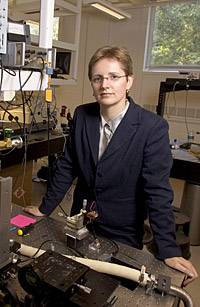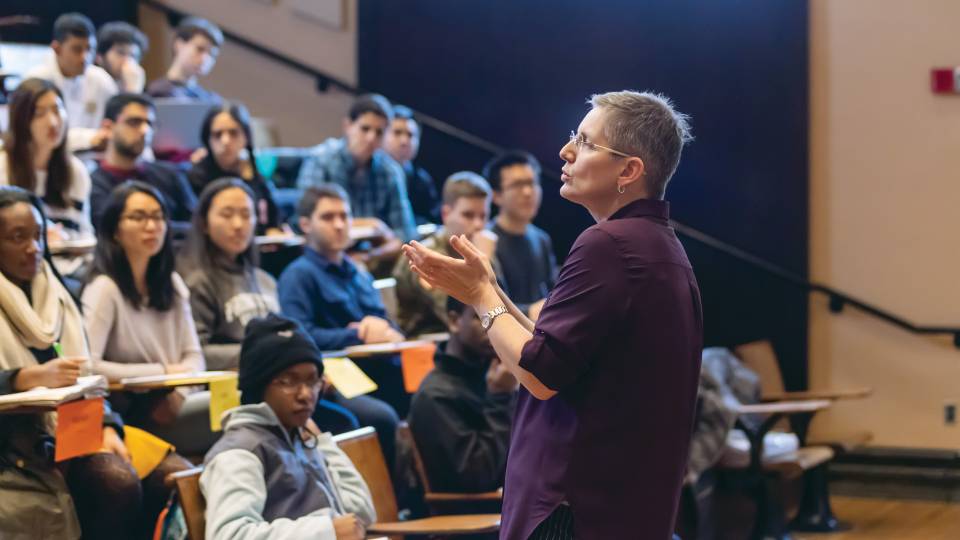Princeton engineer Claire Gmachl
has been selected as a 2005 MacArthur Fellow for her research on highly
versatile lasers that could be used in fields ranging from
environmental monitoring to medical diagnostics and homeland security.
The John D. and Catherine T. MacArthur Foundation announced Sept. 20
that Gmachl is among 25 scholars, scientists and artists who each will
receive $500,000 in unrestricted support over the next five years. The
awards, known informally as "genius grants," are given to people from a
broad range of fields who "demonstrate exceptional creativity and
promise."
Gmachl is the third Princeton scientist or engineer, all women, to
have won a MacArthur Fellowship in the last four years. Bonnie Bassler,
a professor of molecular biology, won in 2002, and Naomi Leonard, a
professor of mechanical and aerospace engineering, won in 2004.
This year's winners also included photographer Fazal Sheikh, a 1987
graduate of Princeton in art and archaeology, and Emily Thompson, a
1992 graduate alumna who is an aural historian and associate
professor of history at the University of California-San Diego. The
foundation cited Sheikh for "using the personalizing power of
portraiture to bring the faces of the world's displaced people into
focus," and Thompson, who earned her Ph.D. from Princeton in the
history of science, for recovering "an important history of our time"
by "charting the transformation of the elusive and ephemeral phenomenon
of sound."
Gmachl (pronounced geh-MAHK-el), an associate professor of electrical engineering,
is a pioneer in creating quantum cascade lasers. The MacArthur
Foundation called her a "wizard at imagining and creating new designs"
for such devices. The lasers are built by stacking atomically thin
layers of materials into wafers that are smaller than a watermelon
seed. Electrons fall or "cascade" through the layers, emitting light at
each step. The devices are less complex and more reliable than current
lasers and can be tuned to emit light in parts of the spectrum that
most other lasers cannot produce.
"Claire is an amazing person," said Maria Klawe, dean of Princeton's
School of Engineering and Applied Science. "She has a deep
understanding of basic physics, but also can translate that knowledge
into technology that will have a major impact on many areas of society.
She is an inspiration to any student who wants to work in science, be
creative and make a difference."
Among many potential uses, quantum cascade lasers could detect trace
gasses in people's breath to reveal the presence of lung, kidney, liver
and other disorders. They also could be used to monitor smokestack or
tailpipe emissions and many other environmental factors. Military
researchers are interested in the technology for detecting explosives
or chemical weapons.
"What fascinates me about this work is that we are making designer
materials," Gmachl said. "By being creative, you can trick these new
materials into doing something that is not available in nature."
Gmachl said the new laser devices offer so much flexibility that even
some of the most far-fetched ideas proposed in her lab have been made
to work. Finding funding to pursue such ideas, however, is not easy,
and that is why Gmachl plans to use the MacArthur award to support
"some really far-out projects" that she has not yet tried or even
proposed.
"I am extremely happy to have this support," said Gmachl, who learned
of the award while she was at a conference on Cape Cod. "I am very
thankful to my peers and my research group, which works so hard with
me. Without this support team, there is no way to win such an award."
Gmachl, a native of Austria, earned her Ph.D. in 1995 from the
Technical University of Vienna. She came to Princeton University in
2003 after working for eight years on the research and technical staffs
of Bell Laboratories, where she joined the group that built the first
quantum cascade laser. Her current research, supported primarily by
grants from the Defense Advanced Research Projects Administration and
the National Science Foundation, is aimed at improving the performance
of and developing new types of quantum cascade lasers and at
understanding the basic physics behind the materials and structures
used in the lasers.

